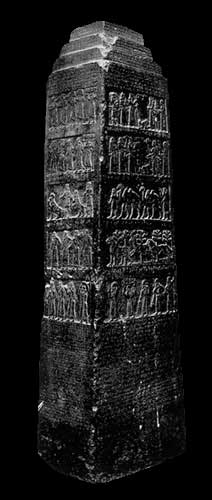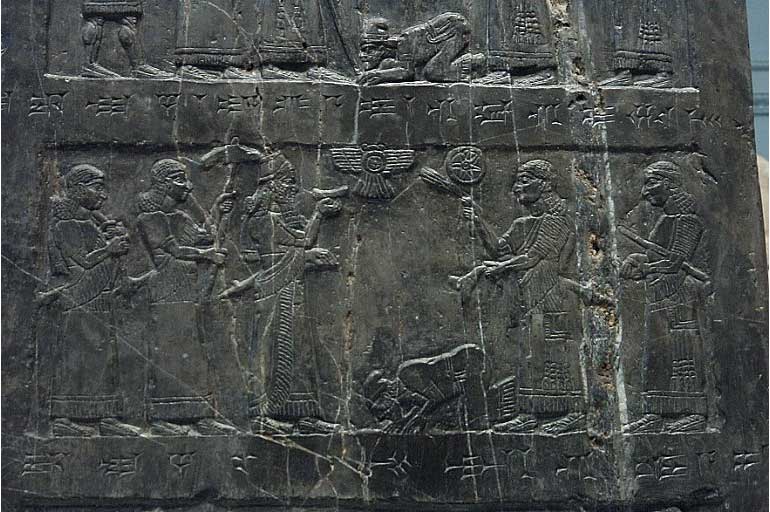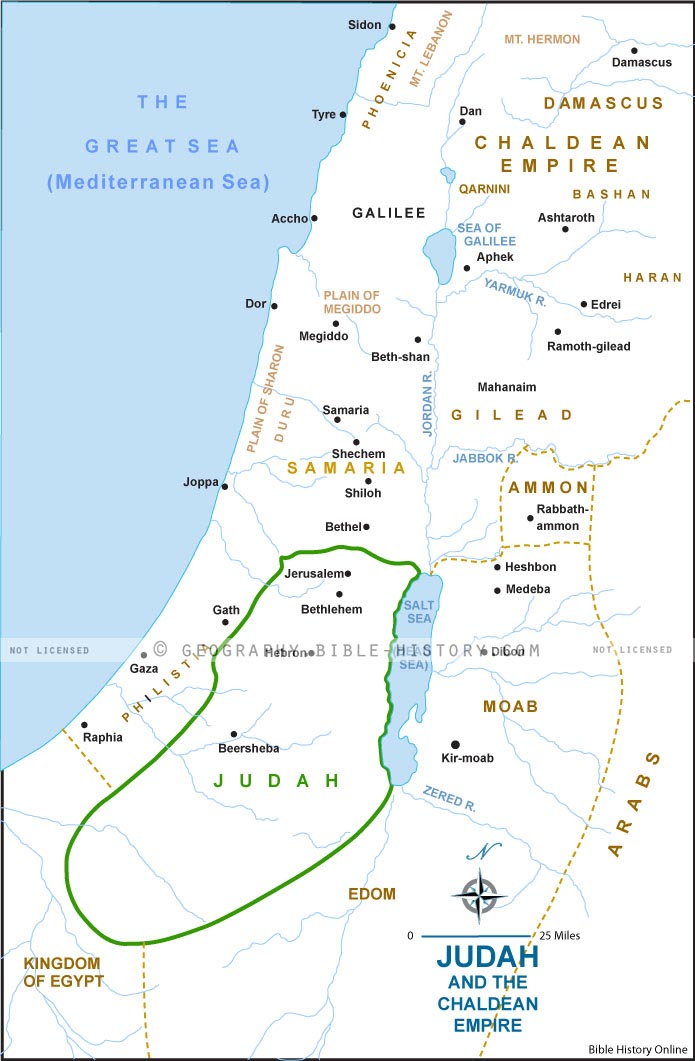Jeremiah Images and
NotesThe Book of Jeremiah
Jeremiah 1:17-19 - Thou therefore gird up thy loins, and
arise, and speak unto them all that I command thee: be not
dismayed at their faces, lest I confound thee before them. For,
behold, I have made thee this day a defenced city, and an iron
pillar, and brasen walls against the whole land, against the
kings of Judah, against the princes thereof, against the priests
thereof, and against the people of the land. And they shall
fight against thee; but they shall not prevail against thee; for
I [am] with thee, saith the LORD, to deliver thee.
Jeremiah 3:16 - And it shall come to pass, when ye be
multiplied and increased in the land, in those days, saith the
LORD, they shall say no more, The ark of the covenant of the
LORD: neither shall it come to mind: neither shall they remember
it; neither shall they visit [it]; neither shall [that] be done
any more. At that time they shall call Jerusalem the throne of
the LORD; and all the nations shall be gathered unto it, to the
name of the LORD, to Jerusalem: neither shall they walk any more
after the imagination of their evil heart.
Jeremiah 23:5-6- Behold, the days come, saith the LORD, that
I will raise unto David a righteous Branch, and a King shall
reign and prosper, and shall execute judgment and justice in the
earth. In his days Judah shall be saved, and Israel shall dwell
safely: and this [is] his name whereby he shall be called, THE
LORD OUR RIGHTEOUSNESS.
The Old Testament - A Brief Overview
Bible Survey - Jeremiah
Hebrew Name - Yirmiyahu "Yah is my appointer"
Greek Name - Ieremias (Greek form of the Hebrew)
Author - Jeremiah (According to Tradition)
Date - 629 BC Approximately
Theme - The destruction of Judah
Types and Shadows - In Jeremiah Jesus is the Lord our righteousness
ARCHAEOLOGY
The Black Obelisk

The Black Obelisk of
Shalmaneser III. Discovered at Calah now in the British
Museum. The Obelisk stands nearly 7 feet tall and is
about 2 feet thick. On each of the 4 sides there are 5
panels with carvings of various kings bringing tribute
to king Shalmaneser III. The second panel from the top
of the obelisk reveals king Jehu of Israel bowing at the
feet of Shalmaneser of Assyria. This is the same Jehu
who is mentioned in Scripture, and this carved relief is
the only image in all history of one of the Hebrew
kings. On the panel Shalmaneser is offering a libation
to his god. The cuneiform text around the panel reads:
"The tribute of Jehu, son of Omri: I
received from him silver, gold, a golden bowl, a golden
vase with pointed bottom, golden tumblers, golden
buckets, tin, a staff for a king [and] spears."

The Jehu Panel on the Black Obelisk
Summary of The Book of Jeremiah
The prophet Jeremiah
prophesied to the Jews in Jerusalem and Judah about 50 years
before Jerusalem would fall and be destroyed by
Nebuchadnezzar of Babylon. Jeremiah continually preached against
the folly of idolatry and pleaded with the people the Word of
God, "what injustice have you found in me?" he cried, "why have
you gone far from me and followed idols, and have become
idolaters?", "I brought you into a beautiful country to eat of
its fruit and its goodness, but you have defiled my land and
made my heritage and abomination." Jeremiah warned that
Jerusalem would be destroyed and the Jews would be taken
away as captives to the land of Babylon. The words of Jeremiah
were violently rejected and he was continually persecuted, but
God warned them at the beginning of his ministry not to be
"afraid of their faces". While Jeremiah was in prison grieving
over the sins of his people the Lord came to him and said
"behold, the days are coming, says the Lord, when I will make a
new covenant" (Jeremiah 31). Soon afterwards Jerusalem was
indeed destroyed in 586 BC as Jeremiah prophesied. But he
claimed that their captivity would only last 70 years and then
they would return to their land. Jeremiah also prophesied
against the pagan nations around Israel. Later he was forced to
go and live in the land of Egypt and there is no record of what
happened to him. - The
above text is © Rusty Russell - Bible History Online and must be
sourced for use on a website.
The prophet Jeremiah began his ministry during the reign of
King Josiah, and he prophesied the Word of the Lord until the
destruction of Jerusalem in 586 BC when Nebuchadnezzar of
Babylon came and destroyed the city and her Temple (Jeremiah 1),
and he continued to prophesy even after this event. Jeremiah
began ministering in 627 BC during the reign of King Josiah, he
was the "son of Hilkiah, of the priests that were in Anathoth"
which was a city near Jerusalem. When the Lord called him he was
very young (Jeremiah 1:6), and the Lord revealed to him that his
word would be rejected and yet he was not to be afraid of their
faces. They also learned that an enemy from the North would come
and bring about the destruction of Jerusalem (Jeremiah 1:11-16),
and this time it would not be the Assyrians as with the northern
kingdom of Israel, but it would be the Babylonians. All the
kings who reigned during the time of Jeremiah were: Josiah,
Jehoa-haz, Jehoiakim, Jehoiachin and Zedekiah and Jerusalem was
destroyed in the 11th year of the reign of king Zedekiah in 586
BC. The event of the burning of the city of Jerusalem and of the
Temple of Solomon is found in 2 Kings 25:8,9 and Jeremiah
52:12-13.
Jeremiah was quick to obey God and to reveal to the children
of Israel in Judah their sins, and as God had warned him he was
hated with much hostility both in his hometown of Anathoth and
in Jerusalem (Jeremiah 11:18-23). It even indicates that his own
family "dealt treacherously" with him (Jeremiah 12:6), but this
was a calm before the storm for Jeremiah who was known as the
weeping prophet. Because of his fearless prophesying during the
reigns of the next four kings of Judah, and the fact that he
predicted the destruction of Jerusalem because of the people's
sins he was hated all the more. He went into hiding because of
the wrath of Jehoiakim who had cut up his book of prophecies and
burned them. Judah finally went into a first wave of captivity
by the Babylonians under Jehoiachin, and they placed Zedekiah in
his stead as a puppet king. Eventually Zedekiah rebelled against
the king of Babylon but was warned by Jeremiah not to do so
(Jeremiah 27:12). Finally the inevitable happened, on the
terrifying day of Av 9 in the Jewish calendar Nebuchadnezzar's
forces destroyedthe Temple of Solomon and the city of Jerusalem
making true all of Jeremiah's prophecies about the Babylonian
invasion.
Jeremiah stayed in Jerusalem but finally was forced to go to
Egypt and his companion and secretary, Baruch came with him.
They are in Egypt, in the city of Tahpanhes we have the last
mention of Jeremiah's life, and after this there is no
information and nothing is certain. His book was completed and
he lived a very long life. According to Christian tradition the
Jews at Tahpanhes, hating him for his prophecies stoned him to
death. There is also a Jewish tradition that when Nebuchadnezzar
had conquered Egypt, Jeremiah and Baruch had escaped to the land
of Judea where they were allowed to die in peace.
The book of Jeremiah is recognized as his own writings and a
complete book just like the book of Isaiah. In Jeremiah 36:1-2,
4, 8, 32 it is written that Jeremiah collected his own writings
and prophecies, some speculate that he put the book together
with Baruch in the land of Egypt but there is no way to know for
certain.
Jeremiah's prophecies consisted of these primary messages:
1 ) The impending destruction of Jerusalem by Babylon;
2 ) the possibility of averting this destruction by repentance;
3 ) the submitting to Babylonian rule after it becomes apparent that domination
is inevitable;
4 ) Babylon herself will be destroyed, never to rise again; and
5 ) Judah will return from captivity and eventually achieve an unsurpassed
glory.
Outline of the Book of Jeremiah
The prophecies contained in the book are not in chronological order, a factor
which makes logical analysis somewhat difficult; however, the following general
divisions of the material is outlined here:
1) The call of Jeremiah (Jeremiah 1).
2) The depravity of Judah and the inevitability of destruction from the north
(Jeremiah 2-6).
3) The illusions of temple security (Jeremiah 7-10). In this section Jeremiah weeps over
the attitude of the people that their formal observance of the temple services
will save them from destruction. He warns them that genuine repentance is their
only hope.
4) Jeremiah's complaint over his own miserable estate and the infidelity of the
Jews of the covenant (Jeremiah 11-12).
5) Further preaching and signs of the impending doom (Jeremiah 13-25). In
Jeremiah 25,
Jeremiah predicted that the length of the captivity would be 70 years.
6) Prophecies and events during the reigns of the last kings of Judah (Jeremiah 26-39 ).
7) Prophecies and events in Judah after the captivity (Jeremiah 40-41).
8) Jeremiah's activity after he is forced to flee to Egypt (Jeremiah 42-51). After a
final exhortation to abandon idolatry (Jeremiah 44), the bulk of this section
consists of prophecies against foreign nations, including a prediction of the
eventual fall and desolation of Babylon.
9) A summary chapter on the captivity of Judah (Jeremiah 52).
Quick Reference Map

Map of Judah and the Chaldean
Empire
(Click to Enlarge)
Quick Reference Maps -
Jeremiah
Judah During the Time of Hezekiah
The New Babylonian Empire and Isaiah
Sites and Events in 2 Kings
Israel and Judah - The kingdoms of Israel and Judah during
the period of the kings can be seen on this map. After Solomon
had died there was a civil war and 10 tribes took to the north
and were called the northern kingdom of Israel, and every king
was evil and forsook the LORD. The remaining 2 tribes stayed in
the south and were called the southern kingdom of Judah, several
of those kings trusted in the LORD.
Mesha's Kingdom - The Bible reveals that Mesha, the king of
Moab rebelled against Jehoram the king of Israel (2 Kings
3:4-5). Jehoram requested the help of Judah and Jehoshaphat
allied with him, he sought Elisha the prophet and victory was
predicted, only because of the faith of Jehoshaphat. Mesha
sought the god Chemosh and sacrificed his own son (2 Kings
3:27).
Israel and Syria Naaman the leper, captain of the Syrian
army was healed by a miracle at the command of Elisha the
prophet (2 Kings 5). At that time Aram (Syria) was a dominant
fighting machine in the north under the leadership of Ben-Hadad,
who was later murdered by Hazael (2 Kings 8:15).
Syria at Its Height - 2 Kings 10 reveals that Hazael of
Syria smote all the coasts of Israel and the east Jordan
territory expanding the kingdom of Damascus. Jehu knew that he
would need to rely on a foreign power for help and he turned to
Shalmanessar IV, King of Assyria.
The Kingdom of Jeroboam II - 2 Kings 14:25 indicates that
Jeroboam II, fourth king from the line of Jehu, brought the
northern kingdom of Israel to its greatest extent in the north.
This was just after Syria was severely crushed by the Assyrians
who had recently returned home to regroup.
Habor, the River of Gozan - In 2 Kings 17:6 the Bible says
that the King of Assyria (Sargon II) conquered Samaria and took
away the remaining inhabitants of Israel as prisoners to
Assyria, and placed them in Halah and in Habor by the river of
Gorzan, and in the cities of the Medes. The river of Gorzan is
identified as the river Khabur, a tributary of the Euphrates
river which flows into it from the north from southern Turkey.
The Cities of Samaria and the Surrounding Lands - The Bible
records in second Kings 17:24 that the King of Assyria (Sargon
II) brought colonists from many of the cities within the
Assyrian Empire: Babylon, Cuthah, Ava, Hamath, and from
Sepharvaim, and placed the inhabitants within the cities of
Samaria to replace the children of Israel who would been taken
into captivity.
The Assyrian Empire When Sennacherib Came to Power - Israel
was destroyed, Judah was left and Hezekiah a man who sought the
LORD had come to power in 720 BC. He offered tribute to
Sennacherib but Jerusalem was was still a target for the
Assyrian ruler.
The Assyrian Empire During the Reign of Esarhaddon -
Esarhaddon marches into Egypt and extends the Assyrian Empire. 2
Kings 19
Necho Battles Josiah - Pharaoh Necho on his way to the
Euphrates slays King Josiah at Megiddo. 2 Kings 23
The Captivity of the Ten Tribes - The ten tribes in the
northern kingdom of Israel were conquered by the Assyrians in
722 BC and taken to the land of Assyria as captives.
Judah Captives in Babylon - The remaining remnant of Judah
were taken as prisoners to Babylon as predicted by Jeremiah the
prophet.
The Babylonian, Mede and Persian Empires - Pharaoh Necho is
defeated by Nebuchadnezzar II of Babylon who also destroyed
Jerusalem in 586 BC. Later the Mede and Persian Empires defeated
Babylon and governed the world in the sixth century BC until
Alexander the Great.

Jeremiah Resources
The Divided Kingdom
The
Northern Kingdom of Israel
The
Southern Kingdom of Judah
The Assyrian Captivity
The Babylonian Captivity
The Return From Babylon
The Prophets
The Messiah
The Book of Jeremiah
More About the Book of
Jeremiah
Jeremiah in the Picture
Study Bible
Timeline of the Ancient
World
Back to the Old Testament
Back to Bible
History Online









